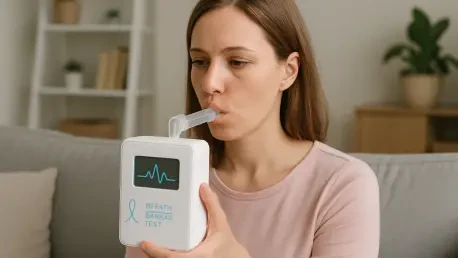Imagine a world where detecting cancer is as simple as breathing into a device or collecting a urine sample at home, with results available almost instantly through a smartphone app, transforming the way we approach early diagnosis. This vision, once confined to science fiction, is rapidly becoming a reality thanks to groundbreaking initiatives supported by substantial funding and cutting-edge research in the United States. The urgency to transform cancer screening cannot be overstated, as late-stage diagnoses continue to claim countless lives due to the limitations of current methods. With only a handful of cancer types covered by standard screenings, millions remain at risk of undetected malignancies. However, a bold new program is aiming to change this landscape by developing non-invasive, at-home Multi-Cancer Early Detection (MCED) tests capable of identifying over 30 different cancers at their earliest, most treatable stages. This shift promises not only to save lives but also to make screening accessible to everyone, regardless of proximity to medical facilities.
Breaking New Ground in Cancer Screening
The Urgent Need for Innovation
The current state of cancer screening reveals a stark gap in public health strategy, with recommended tests in the U.S. covering just four cancer types—breast, cervical, colon, and lung. Many existing MCED tests struggle to detect early-stage solid tumors, often resulting in diagnoses when the disease has progressed to more dangerous levels, drastically reducing survival rates. This limitation underscores the critical need for innovative solutions that can identify cancer at Stage I, where treatment outcomes are significantly more favorable. The development of at-home testing kits using breath and urine samples represents a monumental leap forward. These kits aim to eliminate the need for clinical visits or specialized labs, empowering individuals to take charge of their health from the comfort of home. By focusing on non-invasive methods, this approach seeks to address barriers such as cost, accessibility, and patient reluctance, potentially transforming how society approaches cancer prevention and early intervention.
A Federal Push for Transformation
Driving this revolutionary change is the Advanced Research Projects Agency for Health (ARPA-H), a U.S. federal agency spearheading the Platform Optimizing SynBio for Early Intervention and Detection in Oncology (POSEIDON) program. This ambitious initiative has committed up to $147 million over the next five years, starting now, to fund the creation of over-the-counter cancer detection kits. The program not only prioritizes early-stage detection across a wide spectrum of cancers but also emphasizes integration with digital health records for seamless review by medical professionals. This digital connectivity aims to streamline care workflows, ensuring that test results lead to swift action. Additionally, corporate partners are contributing an extra $21 million in resources, amplifying the scope of research and development. By fostering collaboration between academia and industry, POSEIDON is setting a new standard for how innovation can tackle one of the most pressing health challenges of the era.
Pioneering Technologies and Collaborative Efforts
Diverse Approaches to Detection
Four distinct organizations, selected as performer teams under the POSEIDON program, are leading the charge in developing these next-generation at-home tests with milestone-based funding. Owlstone Medical Limited, a UK-based company, secured $49.1 million to create a breath-based test utilizing a single-use inhaler that detects biomarkers for 36 cancers through synthetic sensors and reporters like DNA barcodes and volatile organic compounds (VOCs). Meanwhile, Carnegie Mellon University, in partnership with Ginkgo Bioworks, is exploring oral probiotic sensors that release customized barcodes detectable in urine via a specialized chip. These varied methodologies highlight the breadth of innovation at play, as each team tackles the challenge of early detection from a unique angle. The focus on non-invasive samples like breath and urine ensures that the tests remain user-friendly, reducing the intimidation factor often associated with medical diagnostics and encouraging widespread adoption.
Cutting-Edge Platforms and Accessibility
Further expanding the technological frontier, Grafton Biosciences, operating in stealth mode, is developing a smartphone-assisted platform for breath and urine detection using oral and inhalable sensors. This integration of everyday technology like smartphones into medical testing could redefine accessibility, allowing users to receive results and guidance without stepping into a clinic. Similarly, SRI International is concentrating on sensors that release barcodes for urine-based cancer detection, offering yet another pathway to accurate diagnostics. The diversity of approaches among these teams reflects a comprehensive exploration of synthetic biology and medical device innovation, all aimed at a common goal: creating low-cost, accurate tests that can be used by anyone, anywhere. Experts involved in the program, including leaders from ARPA-H and the performer teams, consistently emphasize that early detection is the key to improving survival rates, and these pioneering efforts are poised to overcome the longstanding challenges of limited screening options.
Building a Future of Early Intervention
Looking back, the strides made by the POSEIDON program marked a turning point in the fight against cancer, as substantial federal funding and collaborative innovation paved the way for at-home breath and urine tests capable of detecting over 30 cancer types at their earliest stages. The commitment to integrating these tests with digital health platforms ensured that results could swiftly translate into medical action, while the focus on accessibility addressed long-standing disparities in healthcare access. Reflecting on these efforts, it became evident that the next steps involved scaling up production and distribution to ensure these kits reached diverse populations. Continued investment in public education was also crucial to build trust and encourage regular use of such diagnostics. As technology evolved, the hope was to refine accuracy even further, integrating artificial intelligence for personalized risk assessments. These advancements offered a blueprint for how innovation could transform public health, setting a precedent for tackling other complex diseases with equal determination.









